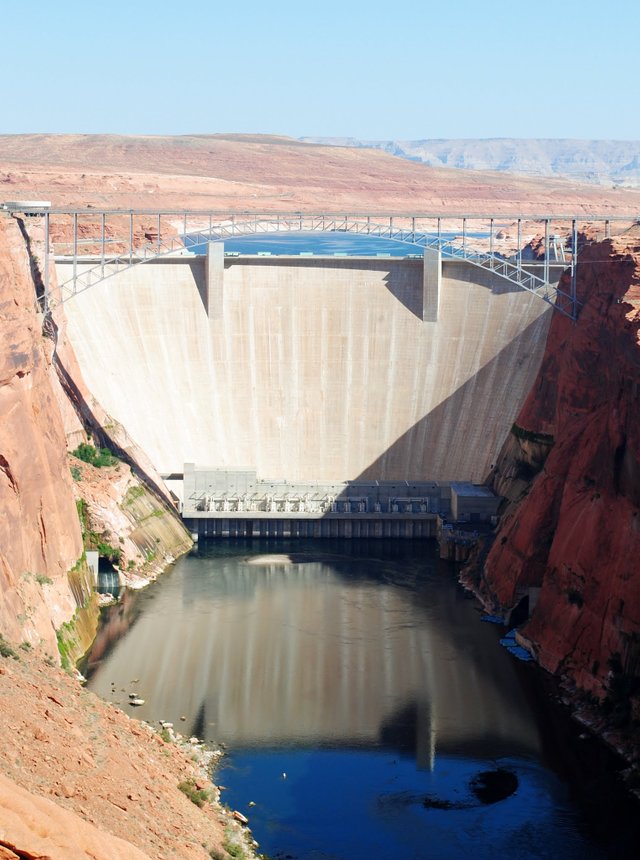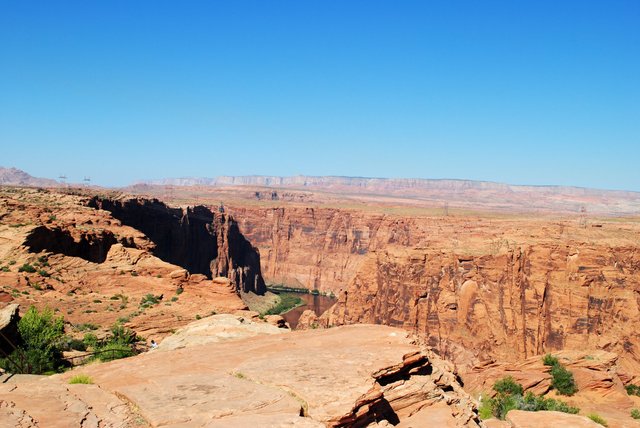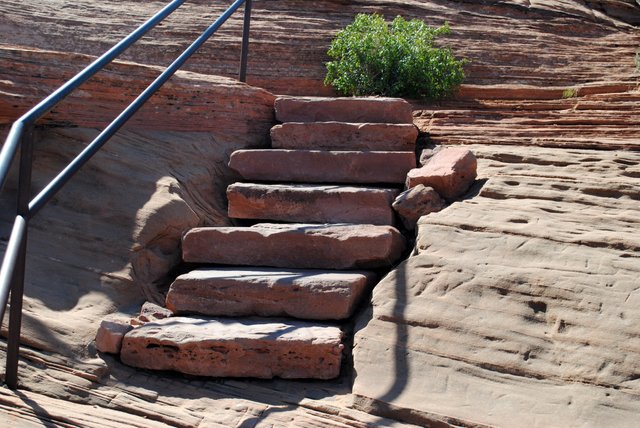Environmental Issues: Grand Canyon #2
The State of the River in the Grand Canyon and What Can Be Done
The Grand Canyon and the Colorado River are inseparable. The river has been carving the massive piece of art for millions of years. It’s as if you can see the very bones of the earth in the walls of the canyon. Grand Canyon National Park encloses 277 miles (466 Km) of Colorado River from Lee’s Ferry almost to Hoover Dam.
Glen Canyon Dam photo courtesy the author
Glen Canyon isn’t officially part of the park, but the Glen Canyon Dam is part and parcel of the Colorado River and very much affects the river at the bottom of the canyon.
The story of the Glen Canyon Dam could have been written by Charles Dickens. “It was the best of times, it was the worst of times.” It is part of the problem and part of the solution.
Glen Canyon Dam was started in 1956 and completed in 1966. It was a ‘compromise’ location as negotiated between the US Bureau of Reclamation and the then brand new environmental movement in the US. The siting work was originally done prior to the construction of Hoover Dam but postponed. Population pressure made the USBR require another Colorado River reservoir in the 50s. Original site chosen was Echo Park, Utah but the original site presented huge ecological and archaeological problems. Glen Canyon was a compromise between the ‘Environmentalists’ and USBR. It was the first time ever that ‘non political’ reasons changed the siting of a major dam.
Glen Canyon photo courtesy the author
It’s a big, impressive structure 710 ft (220m) high at the narrow part of Glen Canyon. It generates 4717 GigaWatts of electricity each year and impounds 27,000,000 acre feet (33 km3) of water spread over 108,000 sq mi (280,000 km2).
The lake behind it is named for John Wesley Powell who was the first known person to navigate the stretch of river from Lee’s Ferry to past where Hoover Dam now sits. It’s an absolutely beautiful place that is a haven for water sports including rental houseboats that are incredibly popular. The side canyons and scenery are just dumbfounding. The reservoir also provides flood protection, irrigation water and a ‘savings account’ for when the river flow doesn’t match the needs downstream.
Sandstone Stairs Glen Canyon Overlook photo courtesy the author
But there is a price. The Grand Canyon and the Colorado River there is a dynamic system that has used the river flow for millions of years to get where we are today. Glen Canyon Dam has altered that dynamic considerably.
As you might guess, wearing that enormous hole in the rock has generated a LOT of silt and sand over the millena. Before the dams on the river the silt was washed downstream under normal circumstances and particularly the Grand Canyon was flushed out to the base rock from time to time in monstrous floods that occured on a more or less regular basis. Now the silt piles up and sits. The sandbars that the canyon is famous for grow and don’t move. The water actually slows down so there isn’t so much erosion. The entire system has been shorted out.
Silt and sand just pile up and stay taking the river flow down and wrecking fish habitat and nesting grounds. It also means the river warms up faster and hotter in the canyon which endangers the native trout.
photo courtesy the author
Attempts to ‘flush the canyon’ with huge releases from Glen Canyon have been mixed at best, but the problem with that is there isn’t enough storage down river to mitigate those releases and the Colorado River water is spoken for by law (The Colorado River Compact). Every drop.
Glen Canyon had another consequence. Thousands of cultural Native American sites were flooded by the rising water. Part of the compromise that would become Glen Canyon valued the ecology of Echo Park over the Antiquities of Glen Canyon.
There are growing calls to remove Glen Canyon Dam but because of the complete usage of the river it is an essential piece in providing for the 40 million that get water from the river. That population is growing and will demand an ever increasing share of the river.
The State of the Water
The quality of the water in the Grand Canyon is being degraded. Not only by the movement of it as controlled by Glen Canyon Dam, but metal pollution is starting to get past the Dam and into the canyon. Uranium, principally.
You might guess that our most prominent national park would be protected from this sort of contamination but you would be wrong. Very wrong.
During WWII and into the 1950s Uranium was a very hot quantity. Mines were opened all over the west, and many of them were not well managed or maintained. Over 500 uranium mines were abandoned on the Navajo Nation alone. The residents there are suffering from abnormally high cancer rates and average roughly 10x the normal amount of uranium in their urine.
Contaminated water is a huge problem in the area. Many miners simply walked away from their mines when the boom for ore ended in the 80s leaving behind surface contamination and settling ponds. At least two of these have ruptured sending large quantities of contaminated silt directly into the river (Often the Little Colorado which joins the Colorado just east of the park boundry.). There are several US Superfund sites in the immediate watershed for the Grand Canyon.
Current Mining
There is currently one active, producing Uranium mine within just a few miles of the park boundary. There is one that has been active and is listed as ‘on standby’ and 6 proposed new mines all within 30 miles of the river. There is also one Federal Cleanup Site actually inside the Park Boundary.
The Obama administration placed a moratorium on mining in the area. The Trump administration is actively trying to break that moratorium. There is a bill working it’s way through congress that would make the ban permanent. As you might guess, one party supports this bill and one opposes it. There is some hope of consensus on the bill because of the Grand Canyon and the importance of it. It’s a hope, and nowhere near a reality at this point.

Source A reclaimed mine
So far, several of the tribes that actually inhabit parts of the canyon are holding the mines at bay with lawsuits that claim not only cultural rights but the right to uncontaminated water.
So the river in the Grand Canyon is threatened. It’s a very real set of threats, and there is no real certainty as to whether or not the river will win out in the end. But the river isn’t the only part of the park that is threatened. We will dig into more environmental issues in the Grand Canyon in the next post. Thank you for following along. If you are appalled by what you’ve read and need to do something you can support the Grand Canyon Trust and tell your congressman to support the Grand Canyon Centennial Protection Act.
All words in this post are mine. The photographs are either sourced properly or taken by me and used courtesy of the author.
You want some really cool stuff? Check these authors, they will not disappoint.
@broncofan99 Sports Teaching Fishing BBQ. Not necessarily in that order.
@morkrock Music Games Stinging Politics. Don't go here with thin skin.
@princessmewmew Food Antiques Food Life Food Cats. Anything of beauty could show up here.
@soyrosa Great Photographs and Insights for us All
@enchantedspirit Astrology and much more. Detailed analysis and more with grace and humor...







I found this both interesting and frustrating to read, it drives me crazy seeing natures beauty and our resources being damaged like this and more needs to be done to protect it without a doubt
The river itself is under threat. Partially because it is completely allocated and the allocations are too large. The new compact will have to reflect that. Later in the series there will be low water photos in Lake Mead and Lake Powell.
Lets hope they can agree and act on something sooner rather than later to protect the river and surrounding environment
Congratulations! This post has been chosen as one of the daily Whistle Stops for The STEEM Engine!
You can see your post's place along the track here: The Daily Whistle Stops, Issue 467
It's sad that such an iconic part of the American nature is under threat... the part that strikes me the most is the mining problem... it is something that is also problematic in Australia and even in The Netherlands...
...like most of our economic systems... there is really no financial cost placed on the "intangible" costs of pollution or clean-up or anything like that. Companies are free to pillage and pollute and they aren't held accountable by government due to a misplaced belief that governments shouldn't restrict wealth production, and the costs and downsides are born by the rest of the population... whilst the companies get away with the "costs" of business.
Anyway, I hope there is some sort of bipartisan sort of solution that is possible... but for things like this, I'm a little cynical... people will only do something when something really bad happens to the ecosystem... and even then, a good chunk of the population will scream "fake"!
What's really sad is that Uranium isn't that hot a commodity at this time, and there are mines that are NOT a threat to the Canyon. I don't have a great deal of faith in the Legislature to bail us out, frankly.
And for the record the Bureau has done a very good job with the abandoned mine inside the Park Boundary. It's a successful Super Fund Site.
Gorgeous photos...
Youre standing a bit too close to the edge. :)
Nope. I am not good on high ledges so there is plenty of room. Seriously.
Thank you!
OMG!!! @catweasel & I were talking about you this week-end. Welcome back. It's -- encouraging -- to see you surface again. Last I saw you'd pretty much vanished -- for totally understandable reasons.
It is tragic how man's interference with nature messes things up, can it be stopped before it's too late? I believe so if we all get proactive wherever we live and join organisations that are working towards a cleaner environment!
Interesting post, these are issues that has to be spoken about @bigtom13!
Posted using Partiko Android
For almost all these problems there are workarounds. It would have been easy to design for some of the problems but they really weren't thought of.
Thanks Lizelle.
Well explained post... Really love the way you explained and discussed about the problem and solutions...
There is a huge balancing act around here. Water is so precious and so utilized that it nearly HAS to be maximized for people. And it affects the entire nation. Colorado River water irrigates over 80% of the Winter lettuce. And LOTS of other veggies...
wow... Thanks for these information... I had no idea about it...
That is really interesting. It is crazy how much damage a dam can do, but also how much it can benefit other areas. It has to be one of the biggest catch 22's or compromises on a global scale. Great pictures!
There has to be a dam in that area, I guess Glen Canyon is as good a spot as any. I fuss so about the Grand Canyon but they are doing minimal damage there and the impoundment behind it is just about priceless. It is a big part of getting the water where it needs to be when.
Oops. I replied to the wrong place. That makes sense.
Posted using Partiko Android
That makes sense
Posted using Partiko Android
Thanks for using eSteem!
Your post has been voted as a part of eSteem encouragement program. Keep up the good work! Install Android, iOS Mobile app or Windows, Mac, Linux Surfer app, if you haven't already!
Learn more: https://esteem.app
Join our discord: https://discord.gg/8eHupPq
To listen to the audio version of this article click on the play image.

Brought to you by @tts. If you find it useful please consider upvoting this reply.